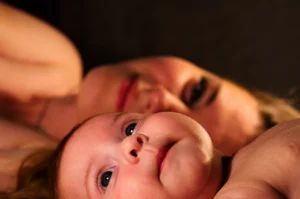Rocky Mountain Sleeping Baby specializes in sleep training, and you may have heard it mentioned several times in our various blogs. Our certified sleep experts share more about what sleep training is and its benefits of it. If you are interested in learning more or want to set up a session, please give us a call, send us an email, or fill out the contact form on the website. We work with families across the United States and look forward to working with yours as your sleep training specialists!
Sleep Training
Sleep training, or as I like to call it “teaching independent sleeping skills” is essentially changing sleep habits to create a structured, routine sleep schedule that relies on your child putting themselves to sleep at naps or bedtime, without aid. We first change habits that are inhibiting a good sleep cycle, and we also switch gears from your child falling asleep with a sleep prop, sleep aid, or an action. These can be such things as being breastfed, a bottle prior to sleeping, a song or a story in bed, or a blanket or favorite animal needed to fall asleep.
The removal of sleep props is only necessary if your child is struggling to sleep. Not all children are negatively affected by sleep props.
Sleeping independently of props or actions is essential to getting full sleep cycles, and not needing aid to fall back asleep if they wake up. Eliminating actions is one of the hardest habits to break. As parents, we love to feel close to our babies through breastfeeding or rocking as they fall asleep. The problem this creates is it forms a habit that they will need these actions to be repeated every they wake up as they have formed an association between the action and sleep. Because you need sleep too, it is important to distance actions from bedtime.
Sleep training begins when your current sleep habits are no longer working. Indications can be any of the following:
- Bedtime is long and getting longer
- Waking up during the night is frequently happening
- Falling back asleep requires an action or prop
- Naptime is short, and becomes a struggle for both of you
- You and your partner are exhausted and dread naps and bedtime
- You feel a little out of control with naps or bedtime
Sleep training is a skill that is not something we are not born with. It will take time, practice, and patience to create a sleep training skill that is repeated daily at nap and bedtimes. A successful sleep training routine can carry your child into their teen and adult years. Sleep training schedules have positive benefits that can include the following:
- At bedtime, your child can be placed in their crib, and fall asleep independently, usually within 10 minutes or less.
- Evenings become more enjoyable again.
- Parents aren’t waiting for the inevitable awakening that requires an action to prompt sleep again.
- Everyone in the family is getting adequate sleep, nightly.
- Naps are on a schedule, and you and your child have an internal clock that indicates nap time.
Starting with a Plan
As we mentioned above, a sleep training plan is key to creating a positive pattern that will be repeated nightly in addition to many beneficial outcomes will include getting full sleep cycles during nap and bedtime. Additional outcomes you may experience include:
- How the current sleep schedules are not beneficial and why they weren’t successful.
- Create a sleep schedule based on your child’s age(s) and how much sleep each age should get during nap and bedtimes. A plan will also include when to end nap times and determine the right amount of wake hours your child needs.
- Following a schedule that repeats nightly starting with when to put your child to bed.
- Training them to fall asleep on their own without aid.
- How and when to intervene when an issue arises, and what are typical and non-typical sleep issues that may come up.
- If your baby is still needing overnight feeds, creating a routine that mimics the time each night, and how to successfully wean off nighttime feedings and sleeping through their feeding time.
- Knowing when something just isn’t going to work, and how to fix or rework the plan.
- If your child still needs naps, when to schedule them and how to manage them.
As we’ve discussed, successful sleep plans will take time and practice, and most of all patience. Sleep training should not be stressful for you, your partner, or your child. While there may be nights that are less positive than others, know that repetition is key, and change can be met with resistance a first. Know that in time, it can become a structured routine with many positive benefits for all of you.
The How: Sleep Training Methods
There are various methods that our certified sleep experts have used, and perfected over time as we work with families across the United States. Know that finding a plan that resonates with you and your family is key to implementing and following a sleep plan. We will discuss a few options below, and if you would like more one-on-one information on what may be best for your family, please reach out to us.
Crying it Out
We all know our grandparents, and maybe even our parents were taught to let us “cry it out” Knowing exactly how long crying it out should last is vital to this method. The idea behind crying it out is leaving your child in their crib at bedtime and regardless of how long they are crying, you do not check on them in person. You can view them through the monitor (if you have one) or wait until morning to let them know you are checking on them.
This method is for families who can handle their child crying without giving into the feeling of wanting to soothe them. It is effective and results can be seen in just a few nights. It can be tough though if you give in and go to your baby because every time that happens, you must start over from the beginning.
Checking-In
The check-in method is like the cry-it-out method though the variation of this plan is you do go in and check on your baby. The idea is you leave your child awake in their crib at bedtime and determine what time(s) of the night you will be checking on them.
You will have a lot of variables to consider, we have notated some of them below:
- How long you wait between check-ins. You must stay consistent, or your child may force themselves to stay awake to see you when you check-in next.
- The amount of time you are in the room must be the same. If you stay in the room 5 minutes one night and 20 the next, this will confuse your child and they will think you are coming back for a longer time frame. We recommend writing a schedule to stick to, so you are consistent.
- Are the check-ins beneficial? How long do you try this method before you decide to start a new plan? How do you measure the benefits of this plan?
The check-in method can work in a short amount time with a lot of patience. The biggest factor is consistency. When you work with one of our certified sleep consultants to create your check-in plan, we help you create a routine that is structured and consistent and we help during this training to support and help you tweak areas that are not producing positive reactions.
Camping in Baby’s Room
Grab the marshmallows and a comfy chair, as this strategy has you camping out in your child’s room as they train.
The idea behind the camping out method is staying in your child’s room until they fall asleep. The variables in this scenario can include the following:
- How long your baby will fight sleep; it could be 5 minutes or an hour.
- Where will you sit while you’re in there?
- Do you intervene if your child starts to cry because they want to be in your arms and not in their crib?
- Upping your sneak-out game to match that of when you were a teenager and didn’t want to wake your parents. Now you’re sneaking out of your kid’s room.
This method takes a little bit more planning, and routine though it does help those parents who prefer this plan and takes about 2 weeks to perfect.
Sleep Props and Sleep Association
We’ve talked about sleep props and sleep association in our previous blogs, though a sleep prop is an item such as a blanket, stuffed animal, or other tangible items that comfort your baby as they fall asleep.
A sleep association is an action that is performed such as breastfeeding, rocking, singing etc. as your baby falls asleep. While you may think a stuffed animal comforts your child, or you love the bond of feedings before bed, these are not beneficial to your child.
If your child has grown accustomed to either of these methods, you will need to begin a plan to slowly remove or reduce the action over a period of time. How long it will take is up to both of you, though we recommend creating a plan, and we are happy to help you with this, so you have a routine to follow to help them reduce their attachment. Note that this sleep training plan takes the longest to accomplish and build a structured routine.
You know your baby better than anyone, and one of these plans will resonate with you more than another. If you start one and feel as though it is not working, it is okay to try a new plan. If you feel frustrated or unsure of which method to try, one of our sleep experts would love to help you. As moms ourselves, we know what you are going through. We learn about your family, and your child and take time to understand their current routine and use their age and what has worked as factors to create a customized plan just for you.
Remember, it is okay to make mistakes during this time. It is a new process for your family and while there are many positive benefits that will arise, it can take time to adjust and create this new routine. Remind yourself that in a few weeks there will be progress and baby is on the path to creating a sleep schedule that can carry them through childhood, teen, and even adult years.
Please give us a call, send us an email, or use the contact form to reach us, and one of our certified sleep experts will work with you to create a customized plan specific to you! We look forward to working with you!
We are sleep consultants in Denver, Colorado, Kansas City, and Ft. Worth, TX but everything we do is virtual. We help families all over the world!





